Amazing Uzbekistan Itinerary
11 Days Private Tour of Tashkent - Nukus - Muynak - Nukus - Khiva - Kyzylkum Desert - Bukhara - Shakhrisabz - Samarkand - Tashkent
Tour Type: Private guided tour, flexible and customizable
Transportation: Comfortable air-conditioned private car with driver
Accommodation: 3 to 4-star hotels, open to your own choice
Meals: 10 breakfasts
Code: TUZ04
Transportation: Comfortable air-conditioned private car with driver
Accommodation: 3 to 4-star hotels, open to your own choice
Meals: 10 breakfasts
Code: TUZ04
This trip can be customized to meet your individual needs!
From USD2049USD1803Free Inquiry
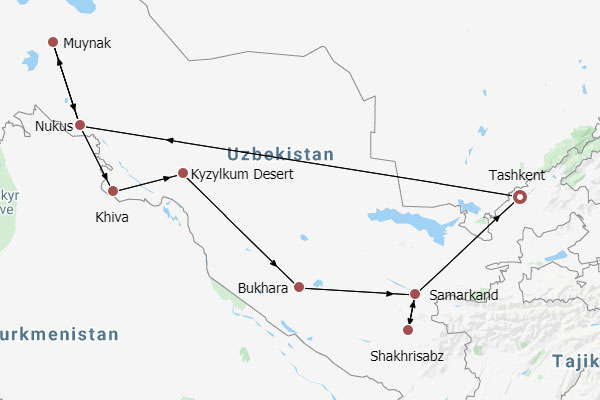
- Itinerary
- Prices
- Reviews
Trip Highlights
- Witness rusted fleets stranded in the dried Aral Sea at the Cemetery of Ships.
- Explore the once-banned Soviet avant-garde art at the Art Museum in Nukus.
- Unveil the majestic life story of the Great Timur by visiting the grand architecture in Samarkand.
- Admire the sunset view of Khiva by ascending the rampart of its UNESCO-listed inner city, Ichan Kala.
- Immerse yourself in the authentic Uzbek daily life at Chorsu Bazaar and Siyob Bazaar.
Expand All
Collapse All
Day 1 Tashkent Airport Pick-up; Visit Chorsu Bazaar, State Museum of Applied Art, Tashkent Metro
Are you ready to embark on your desert safari of Uzbekistan? For enthusiasts of Islamic architecture and Central Asian culture, Uzbekistan stands as the best destination. This legendary land, featuring lapis lazuli domes, cobalt-blue tiles, and echoing with the chime of camel bells, is said to have inspired the tales of One Thousand and One Nights, alluring every explorer.
Upon your arrival, our Tashkent-based driver will pick you up at the airport and transfer you to the hotel for check-in. After settling down, your private guide will meet you at the lobby and accompany you to the first destination, the Khast-Imam Complex. Composed of two Islamic schools, a mosque, and a mausoleum, it is considered the city’s spiritual center. Then, jump headfirst into the chaotic Chorsu Bazaar to let your nose be titillated by the fragrance of spices and hear the buzz of stallers and customers. Soak up its open-air section to hunt for not only handicrafts, such as wooden carvings, embroideries, and miniatures, but also for Uzbek street food, like samsa, bread, and kebabs.
Continue driving northward to the State Museum of Applied Art, a lively encyclopedia of Uzbek craftsmanship, which showcases exquisite handicrafts from across the country, including silks from Bukhara and Samarkand, glazed ceramics of Rishtan, and textiles from the Fergana Valley. Remember to look around at its ceilings, niches, and columns while admiring collections. Besides, the façade of the main hall is highly photogenic thanks to the speedwell-like motifs.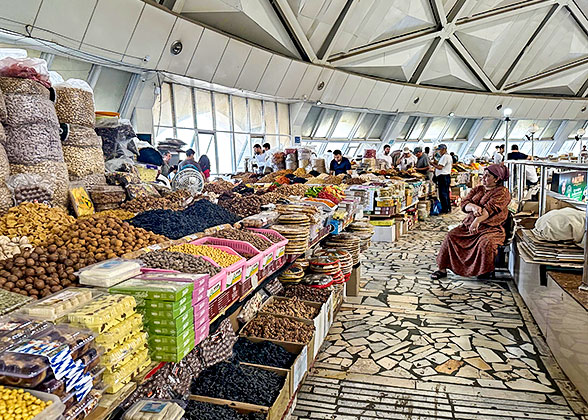
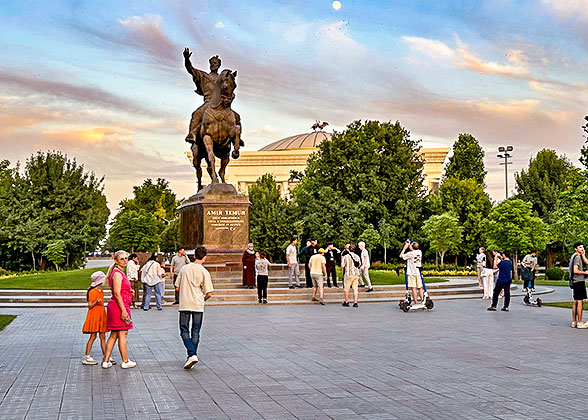 Getting out of the museum, hop on the Tashkent metro, which is regarded as an aesthetic ‘museum’ more than a transportation system. Disembark at the Independence Square Station, where you’ll be staggered by the marble columns, with receptacle-like chapiters supporting ceilings hanging with crystal chandeliers. For more exploration, the Alisher Navoiy station is one of the must-visit stations. Named after the revered 15th-century Turkic poet Alisher Navoiy, it features green-tiled reliefs depicting scenes from his epic poem and ceilings adorned with intricate Central Asian patterns.
Getting out of the museum, hop on the Tashkent metro, which is regarded as an aesthetic ‘museum’ more than a transportation system. Disembark at the Independence Square Station, where you’ll be staggered by the marble columns, with receptacle-like chapiters supporting ceilings hanging with crystal chandeliers. For more exploration, the Alisher Navoiy station is one of the must-visit stations. Named after the revered 15th-century Turkic poet Alisher Navoiy, it features green-tiled reliefs depicting scenes from his epic poem and ceilings adorned with intricate Central Asian patterns.
► Tip: Mobile phone use is generally allowed. However, using a tripod requires prior approval from the patrolling metro police to avoid it being confiscated.
Returning to the ground, our driver will meet you at Independence Square. Roaming across the plaza, pay your respects to the Timur statue on the Amir Timur Square, and finally conclude today’s itinerary at the Earthquake Memorial to mourn victims in the 1966 earthquake. At the end of the day, you’ll be escorted to the hotel.
 Currency and Payment in Uzbekistan:
Currency and Payment in Uzbekistan:
In major tourist cities, like Tashkent, Samarkand, Bukhara, and Khiva, the Visa card is widely accepted at restaurants and shops. However, local bazaars and small stores deal only in Uzbekistan som (UZS) cash. You can exchange some at the ATMs, which are easily found on the streets. Most machines only accept Visa cards, Maestro cards, or US dollars. USD 1 ≈ UZS 13,000.
Meals: Breakfast
Accommodation: Wyndham Tashkent (4 stars) or similar
Upon your arrival, our Tashkent-based driver will pick you up at the airport and transfer you to the hotel for check-in. After settling down, your private guide will meet you at the lobby and accompany you to the first destination, the Khast-Imam Complex. Composed of two Islamic schools, a mosque, and a mausoleum, it is considered the city’s spiritual center. Then, jump headfirst into the chaotic Chorsu Bazaar to let your nose be titillated by the fragrance of spices and hear the buzz of stallers and customers. Soak up its open-air section to hunt for not only handicrafts, such as wooden carvings, embroideries, and miniatures, but also for Uzbek street food, like samsa, bread, and kebabs.
Continue driving northward to the State Museum of Applied Art, a lively encyclopedia of Uzbek craftsmanship, which showcases exquisite handicrafts from across the country, including silks from Bukhara and Samarkand, glazed ceramics of Rishtan, and textiles from the Fergana Valley. Remember to look around at its ceilings, niches, and columns while admiring collections. Besides, the façade of the main hall is highly photogenic thanks to the speedwell-like motifs.

Chorsu Bazaar, Tashkent

Amir Timur Square
► Tip: Mobile phone use is generally allowed. However, using a tripod requires prior approval from the patrolling metro police to avoid it being confiscated.
Returning to the ground, our driver will meet you at Independence Square. Roaming across the plaza, pay your respects to the Timur statue on the Amir Timur Square, and finally conclude today’s itinerary at the Earthquake Memorial to mourn victims in the 1966 earthquake. At the end of the day, you’ll be escorted to the hotel.
In major tourist cities, like Tashkent, Samarkand, Bukhara, and Khiva, the Visa card is widely accepted at restaurants and shops. However, local bazaars and small stores deal only in Uzbekistan som (UZS) cash. You can exchange some at the ATMs, which are easily found on the streets. Most machines only accept Visa cards, Maestro cards, or US dollars. USD 1 ≈ UZS 13,000.
Meals: Breakfast
Accommodation: Wyndham Tashkent (4 stars) or similar
Day 2 Fly to Nukus - Mizdakhan Necropolis - Cemetery of Ships in Muynak - Return to Nukus
After checking out in the morning, the driver will transfer you to the airport to board the flight to Nukus. As soon as you land, our local driver will escort you directly to the Mizdakhan Necropolis, which initially served as a Zoroastrian sanctuary dating back to the 4th century BC. Later, it flourished as the second-largest city of the Khwarezmian Empire (1077-1231). In the 8th century, conquered by the Arabs, it had gradually transformed into a cemetery for Muslims. On some graves, you’ll find ladders, called tabuts, which are said to be prepared for the deceased to ascend to paradise.
Another 3-hour drive will lead you to Muynak, an off-the-radar destination in Uzbekistan. Once a thriving fishing port by the vast Aral Sea in the early 20th century. Due to the unsuitable agricultural policy launched by the Soviet Union, the Amu Darya River and the Syr Darya River, which once fed the Aral Sea, were diverted to irrigate the cotton fields, leading to the dramatic shrinkage of the vast waters. Head to the Cemetery of Ships, the dried-up port of Muynak, and you can have a glimpse of its prosperity through the rusted hulls scattered in the arid expanse. Bold ones can climb up the vessels, but please watch out for the sharp metal edges. If interested, you can wander to the dunes east of the wrecks, where a lighthouse watches the desiccated Aral Sea.
Nearby, the Regional History and Aral Sea Museum records the ecological catastrophe through satellite images. You can briefly learn about the sea’s past by old photos of fishermen, preserved specimens of extinct local wildlife, and a detailed 1:10 scale model of a traditional fishing vessel. After that, the driver will transfer you back to the hotel in Nukus, taking 3-4 hours on the way.
Meals: Breakfast
Accommodation: Tashkent Hotel, Nukus (3 stars) or similar
Another 3-hour drive will lead you to Muynak, an off-the-radar destination in Uzbekistan. Once a thriving fishing port by the vast Aral Sea in the early 20th century. Due to the unsuitable agricultural policy launched by the Soviet Union, the Amu Darya River and the Syr Darya River, which once fed the Aral Sea, were diverted to irrigate the cotton fields, leading to the dramatic shrinkage of the vast waters. Head to the Cemetery of Ships, the dried-up port of Muynak, and you can have a glimpse of its prosperity through the rusted hulls scattered in the arid expanse. Bold ones can climb up the vessels, but please watch out for the sharp metal edges. If interested, you can wander to the dunes east of the wrecks, where a lighthouse watches the desiccated Aral Sea.
Nearby, the Regional History and Aral Sea Museum records the ecological catastrophe through satellite images. You can briefly learn about the sea’s past by old photos of fishermen, preserved specimens of extinct local wildlife, and a detailed 1:10 scale model of a traditional fishing vessel. After that, the driver will transfer you back to the hotel in Nukus, taking 3-4 hours on the way.
Meals: Breakfast
Accommodation: Tashkent Hotel, Nukus (3 stars) or similar
Day 3 Morning Visits in Nukus, Drive to Khiva with Stops at Chilpik Dakhma and Toprak-Kala
After breakfast, our driver will take you to the Savitsky Karakalpakstan Art Museum, where an English-speaking museum guide will be arranged for you. Founded in 1966 by Soviet artist and archaeologist Igor Savitsky, the museum preserves avant-garde artworks banned by the Soviet authorities and traditional Karakalpak folk art and crafts, such as carpets, harnesses, and wooden carvings, from the 19th to 20th centuries. Among its masterpieces, Alexander Volkov’s painting The Bull is crowned as the greatest treasure. The blue animal with two long and sharp horns in the picture looks at you with its black, hollow eyes, bringing an unsettling feeling. Then, drop by the statue of Karakalpak poet Berdakh, the Nukus City Hall, and take some photos with the Drama Theatre that blends traditional Uzbekistan architectural style with modern tastes.
Leaving Nukus and dashing southeastward, you’ll be captivated by an outstanding mount, Chilpik Dakhma, one of the best-preserved ancient Khwarezm’s Zoroastrian monuments built from the 1st century BC to the 1st century. The staircases will lead you to its top, where the weathered dakhma, the sky burial site of Zoroastrianism, stands. Zoroastrians believe that the corpses may contaminate the earth, fire, and water, so the dead would be exposed until the flesh was entirely eaten by scavenging vultures. The remaining bones would be conserved in the ceramic ossuaries. Standing at the edge of the platform, you can see the Amu Darya River winding through the desert plains.
Go forward, and the ruin of the Toprak-Kala will unfold. Constructed in the 1st century BC, the citadel flourished as the Khwarezmian capital during its 2nd century. Climbing the surviving city walls, you’ll see the ancient alleys intertwined with each other like a spider web.
Then, hit the road to the southwest to Khiva, one of the best-preserved ancient cities on the Silk Road. Built in the 5th-4th centuries BC, the city showcases its story and medieval charm by mosques adorned with miniature paintings, soaring minarets, and bustling bazaars. Upon arrival, you’ll be transferred to the hotel for check-in.
Meals: Breakfast
Accommodation: Hotel Asia Khiva (3 stars) or similar
Leaving Nukus and dashing southeastward, you’ll be captivated by an outstanding mount, Chilpik Dakhma, one of the best-preserved ancient Khwarezm’s Zoroastrian monuments built from the 1st century BC to the 1st century. The staircases will lead you to its top, where the weathered dakhma, the sky burial site of Zoroastrianism, stands. Zoroastrians believe that the corpses may contaminate the earth, fire, and water, so the dead would be exposed until the flesh was entirely eaten by scavenging vultures. The remaining bones would be conserved in the ceramic ossuaries. Standing at the edge of the platform, you can see the Amu Darya River winding through the desert plains.
Go forward, and the ruin of the Toprak-Kala will unfold. Constructed in the 1st century BC, the citadel flourished as the Khwarezmian capital during its 2nd century. Climbing the surviving city walls, you’ll see the ancient alleys intertwined with each other like a spider web.
Then, hit the road to the southwest to Khiva, one of the best-preserved ancient cities on the Silk Road. Built in the 5th-4th centuries BC, the city showcases its story and medieval charm by mosques adorned with miniature paintings, soaring minarets, and bustling bazaars. Upon arrival, you’ll be transferred to the hotel for check-in.
Meals: Breakfast
Accommodation: Hotel Asia Khiva (3 stars) or similar
Day 4 Khiva: Kalta Minor Minaret, Juma Mosque, Tosh-Hovli Palace, Kunya-Ark
In the morning, our guide will meet you at the hotel and accompany you to Ichan Kala, the inner city of Khiva, which was designated as a UNESCO Heritage site in 1990. Passing by two Islamic schools, Muhammad Aminkhan Madrasah and Muhammad Rahim Khan Madrasah, we will stop at the adjacent Kalta Minor Minaret. It is said that the Khan planned to build a 70-meter-high (229-foot) tower, but the hostile regime lured away the architect with promises of wealth, leaving a semi-finished structure that resembles a glazed blue pot, soaring 29 meters (95 feet).
To its west, the Juma Mosque hides behind a wooden door. Dating to the 10th century, this sanctuary served as Khorezm’s spiritual heart before Mongol invasions. Rebuilt in the 18th century, it breaks the traditional Central Asia architectural style under the influence of Arabian and Persian culture. Without a central dome, its flat roof is supported by 218 wooden columns. Closely, you can find that some of them bear scorch marks and blade scars, others display intricate carvings, while a few remain rough-hewn logs. On sunny days, sunlight streams through the central skylight, casting a profound atmosphere of tranquility over the colonnades.
To appreciate Khiva’s most alluring decoration, let’s step into the Tosh-Hovli Palace, once the residence of the Khans, known for its exquisitely carved stone pillars, majolica-adorned walls and ceilings, and royal remnants, like carpets, chairs, and copper kettles. After paying your respects to the 14th-century poet and warrior, Pakhlavan Makhmud, resting under the emerald dome of the Pakhlavan Makhmud Mausoleum, we will stop at the foot of Khiva’s tallest tower, the Islam Khodja Minaret. If interested, you can climb to its top for a vista of the distant desert and the old city.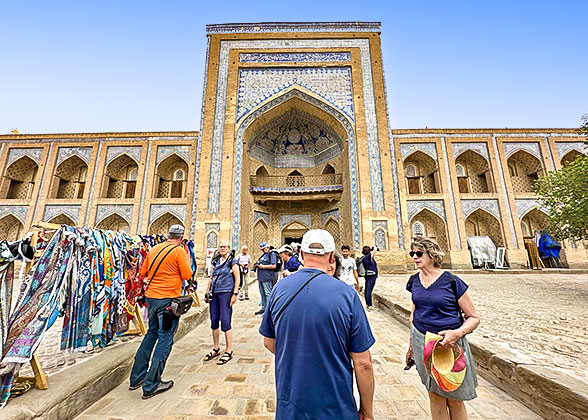
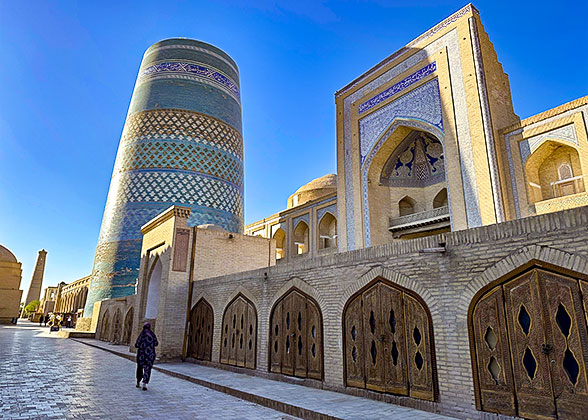 Finally, stop by the Kunya-Ark, which is considered “the city within the city”. Founded between 1686 and 1688 by Arang Khan’s heir, the citadel served as a royal residence and administrative stronghold. Wander through its restored mint, summer mosque, and prison, and learn about the aristocratic life in the past by visiting its museum. For a panoramic view over Khiva’s skyline, ascend the watchtower at the fortress’s northwest corner. After the guided tour, you can explore the city freely and return to the hotel on your own.
Finally, stop by the Kunya-Ark, which is considered “the city within the city”. Founded between 1686 and 1688 by Arang Khan’s heir, the citadel served as a royal residence and administrative stronghold. Wander through its restored mint, summer mosque, and prison, and learn about the aristocratic life in the past by visiting its museum. For a panoramic view over Khiva’s skyline, ascend the watchtower at the fortress’s northwest corner. After the guided tour, you can explore the city freely and return to the hotel on your own.
 Free-Time Khiva Cuisine Exploration (at your own expense)
Free-Time Khiva Cuisine Exploration (at your own expense)
Roam through the alleys, and the stalls filled with sizzling kebabs, samsas, and plov will let you lick your chops. You must not miss the Shivit Oshi- special Khiva green noodles, which initially emerged during the Khwarezmian era (1077-1231). The noodles are dyed green with fresh dill juice, and traditionally, stewed beef or lamb with carrots, potatoes, and onions is added as a topping. Locals usually eat it with sour cream or yogurt. You can savor it at Khorezm Art Restaurant and Khiva Moon Restaurant, which costs UZS 69,000 (USD 5.5).
Meals: Breakfast
Accommodation: Hotel Asia Khiva (3 stars) or similar
To its west, the Juma Mosque hides behind a wooden door. Dating to the 10th century, this sanctuary served as Khorezm’s spiritual heart before Mongol invasions. Rebuilt in the 18th century, it breaks the traditional Central Asia architectural style under the influence of Arabian and Persian culture. Without a central dome, its flat roof is supported by 218 wooden columns. Closely, you can find that some of them bear scorch marks and blade scars, others display intricate carvings, while a few remain rough-hewn logs. On sunny days, sunlight streams through the central skylight, casting a profound atmosphere of tranquility over the colonnades.
To appreciate Khiva’s most alluring decoration, let’s step into the Tosh-Hovli Palace, once the residence of the Khans, known for its exquisitely carved stone pillars, majolica-adorned walls and ceilings, and royal remnants, like carpets, chairs, and copper kettles. After paying your respects to the 14th-century poet and warrior, Pakhlavan Makhmud, resting under the emerald dome of the Pakhlavan Makhmud Mausoleum, we will stop at the foot of Khiva’s tallest tower, the Islam Khodja Minaret. If interested, you can climb to its top for a vista of the distant desert and the old city.

Muhammad Aminkhan Madrasah, Khiva

Kalta Minor
Roam through the alleys, and the stalls filled with sizzling kebabs, samsas, and plov will let you lick your chops. You must not miss the Shivit Oshi- special Khiva green noodles, which initially emerged during the Khwarezmian era (1077-1231). The noodles are dyed green with fresh dill juice, and traditionally, stewed beef or lamb with carrots, potatoes, and onions is added as a topping. Locals usually eat it with sour cream or yogurt. You can savor it at Khorezm Art Restaurant and Khiva Moon Restaurant, which costs UZS 69,000 (USD 5.5).
Meals: Breakfast
Accommodation: Hotel Asia Khiva (3 stars) or similar
Day 5 Drive 7 Hours to Bukhara across the Kyzylkum Desert
Bid farewell to Khiva, jump into the car with our driver, and head to Bukhara. On the way, we need to traverse the vast Kyzylkum Desert. True to its Turkic name meaning "Red Sand," the desert reveals crimson dunes that ignite like smoldering embers under sunlight. As our vehicle advances, watch for ancient riverbeds, wind-sculpted rock formations, and sporadic oases. When the breeze puffs across, ripples are left on the slopes, creating a symphony of light and shadow. If lucky, you may encounter gazelles darting from the bushes or wild camels grazing near the road.
► Tip: Neck pillows and motion sickness medication are recommended since the roads in the desert are not paved. Besides, temperatures (July-August) regularly exceed 40°C (104°F) in summer, so please prepare high-SPF sunscreen and some bottled water to avoid heatstroke.
As soon as you arrive in Bukhara after 7-8 hours, the driver will transfer you directly to the hotel. Please have a good rest to refresh from the fatigue of the road trip.
 Where to Kill Time (at your own expense):
Where to Kill Time (at your own expense):
Do not want to waste your time lying in bed? Head to the Silk Road Spices Teahouse. The suzani embroideries and handwoven carpets hanging on the walls and the yellow wooden furniture create a medieval caravanserai ambiance. Sip their hot-selling Cardamom & Saffron Blend, paired with raisins and candied dates. It also offers Turkish coffee, whose bitterness is lifted by cardamom, but rock sugar can give a good balance.
Average Cost Each Tea Set: UZS 50,000 (USD 4). Unlimited refill of hot water.
Address: Khakikat Str., Buxoro Viloyati, Uzbekistan
Meals: Breakfast
Accommodation: Volida Hotel Bukhara (3 stars) or similar
► Tip: Neck pillows and motion sickness medication are recommended since the roads in the desert are not paved. Besides, temperatures (July-August) regularly exceed 40°C (104°F) in summer, so please prepare high-SPF sunscreen and some bottled water to avoid heatstroke.
As soon as you arrive in Bukhara after 7-8 hours, the driver will transfer you directly to the hotel. Please have a good rest to refresh from the fatigue of the road trip.
Do not want to waste your time lying in bed? Head to the Silk Road Spices Teahouse. The suzani embroideries and handwoven carpets hanging on the walls and the yellow wooden furniture create a medieval caravanserai ambiance. Sip their hot-selling Cardamom & Saffron Blend, paired with raisins and candied dates. It also offers Turkish coffee, whose bitterness is lifted by cardamom, but rock sugar can give a good balance.
Average Cost Each Tea Set: UZS 50,000 (USD 4). Unlimited refill of hot water.
Address: Khakikat Str., Buxoro Viloyati, Uzbekistan
Meals: Breakfast
Accommodation: Volida Hotel Bukhara (3 stars) or similar
Day 6 Bukhara: Lyabi Hauz Ensemble, Trade Domes Market, Kalyan Minaret, Ark Fortress
Today, the guide will accompany you to glimpse the highlights of Bukhara. While Khiva exudes restored elegance, the 2,500-year-old Bukhara emphasizes practicality with its ubiquitous earthy houses, which are old but bring a more nostalgic atmosphere to the city.
Start with the Lyabi Hauz Ensemble in the city center, considered the most vibrant square of Bukhara, where ancient Islamic schools and a Sufi shrine blend with modern restaurants, cafes, and souvenir stores, surrounding a central pond. Across the ensemble, peek at the weathered brickwork of the Magoki-Attori Mosque’s façade, and see traditional Bukhara handmade carpets at its museum. Nearby, the Chor-Minor Madrasah glitters with its four blue domes, which once featured on the cover of Lonely Planet Central Asia. If interested, you can ascend to its central dome, which offers a close-up view of the blue-tiled towers and the surrounding cityscape. It is said that there were once a couple of storks nestled on the top, bringing babies to newlyweds, but they disappeared during the tower’s reconstruction. Now there is a sculpture of them; just make a wish and it may still come true.
Then, dive into the bustling Trade Domes Market to feel the charm of local handicrafts. Set as the capital of the Shaybanid Dynasty in the 16th century, Bukhara became a commercial center, with the prosperous Trade Domes Market booming. Of the ten trading domes, only four survive today, in which you can find jewelry, metal works, hats, textiles, and suzani embroideries. The crafts in the market are usually overpriced, so please ask for 30-50% off the initial quotes if you want to buy them.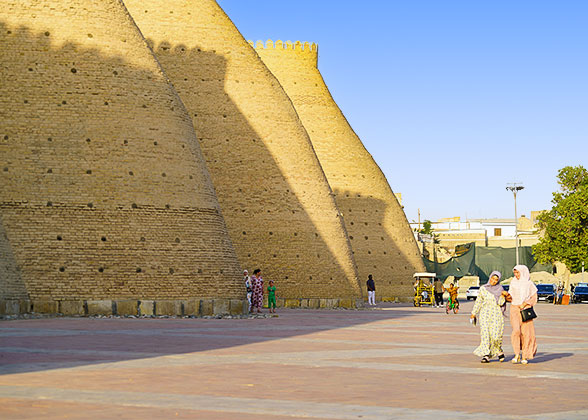
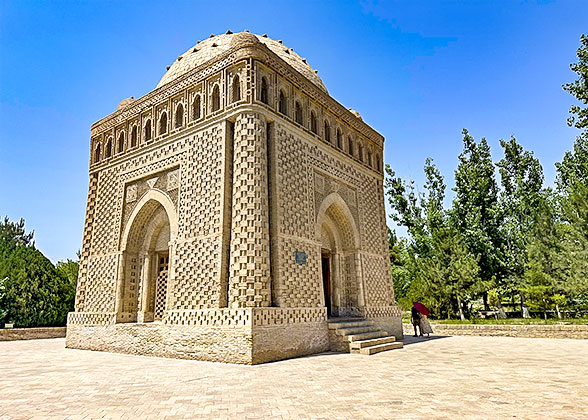 Afterwards, drop by Ulugh Beg Madrasah and Abdulaziz Khan Madrasah, and stop at the Poi-Kalyan Complex. Surrounded by Miri-Arab Madrasah and Kalyan Mosque, the complex is dominated by Kalyan Minaret. Built in the 12th century, the tower soars up 47 meters (154 feet). Initially, it was constructed to be a symbol of the royal, but ironically, it became an execution site after the 16th century. Looking up from its base, you’ll be staggered by the 14 bands of glazed terracotta patterns.
Afterwards, drop by Ulugh Beg Madrasah and Abdulaziz Khan Madrasah, and stop at the Poi-Kalyan Complex. Surrounded by Miri-Arab Madrasah and Kalyan Mosque, the complex is dominated by Kalyan Minaret. Built in the 12th century, the tower soars up 47 meters (154 feet). Initially, it was constructed to be a symbol of the royal, but ironically, it became an execution site after the 16th century. Looking up from its base, you’ll be staggered by the 14 bands of glazed terracotta patterns.
After passing by the Miri-Arab Madrasah, we will enter the Ark Fortress, the stronghold built by the Sogdians in the 1st century BC, which later became Bukhara’s political nucleus. Its palaces, mosques, armories, and prisons have witnessed its repeated devastation and reconstruction. In the small museum, you can see excavated pottery, weapons, and embossments of the Zoroastrian fire altar. Ascend the meandering ramparts at dusk to admire the golden-hued skyline bathed in the twilight.
Finally, let’s capture the inverted reflection of the 20 carved pillars in the pond at the Bolo Hauz Mosque, appreciate the 9th-10th century masterpiece piled with bricks at the Samanid Mausoleum, and conclude today’s itinerary at the Chashma Ayub Mausoleum, known for its healing springs. At the end of the day, the driver will send you back to the hotel.
Meals: Breakfast
Accommodation: Volida Hotel Bukhara (3 stars) or similar
Start with the Lyabi Hauz Ensemble in the city center, considered the most vibrant square of Bukhara, where ancient Islamic schools and a Sufi shrine blend with modern restaurants, cafes, and souvenir stores, surrounding a central pond. Across the ensemble, peek at the weathered brickwork of the Magoki-Attori Mosque’s façade, and see traditional Bukhara handmade carpets at its museum. Nearby, the Chor-Minor Madrasah glitters with its four blue domes, which once featured on the cover of Lonely Planet Central Asia. If interested, you can ascend to its central dome, which offers a close-up view of the blue-tiled towers and the surrounding cityscape. It is said that there were once a couple of storks nestled on the top, bringing babies to newlyweds, but they disappeared during the tower’s reconstruction. Now there is a sculpture of them; just make a wish and it may still come true.
Then, dive into the bustling Trade Domes Market to feel the charm of local handicrafts. Set as the capital of the Shaybanid Dynasty in the 16th century, Bukhara became a commercial center, with the prosperous Trade Domes Market booming. Of the ten trading domes, only four survive today, in which you can find jewelry, metal works, hats, textiles, and suzani embroideries. The crafts in the market are usually overpriced, so please ask for 30-50% off the initial quotes if you want to buy them.

Ark Fortress, Bukhara

Chashma Ayub Mausoleum
After passing by the Miri-Arab Madrasah, we will enter the Ark Fortress, the stronghold built by the Sogdians in the 1st century BC, which later became Bukhara’s political nucleus. Its palaces, mosques, armories, and prisons have witnessed its repeated devastation and reconstruction. In the small museum, you can see excavated pottery, weapons, and embossments of the Zoroastrian fire altar. Ascend the meandering ramparts at dusk to admire the golden-hued skyline bathed in the twilight.
Finally, let’s capture the inverted reflection of the 20 carved pillars in the pond at the Bolo Hauz Mosque, appreciate the 9th-10th century masterpiece piled with bricks at the Samanid Mausoleum, and conclude today’s itinerary at the Chashma Ayub Mausoleum, known for its healing springs. At the end of the day, the driver will send you back to the hotel.
Meals: Breakfast
Accommodation: Volida Hotel Bukhara (3 stars) or similar
Day 7 Bukhara: Summer Palace, Chor-Bakr Necropolis; High-speed Train to Samarkand
Together with our guide, embark on a Bukhara side trip today. Drive to the suburb, and we will first stop at the Summer Palace, also known as Sitorai Mohi Hosa. Built by the last khan of Bukhara, it is a memorial to his wife, who died in childbirth. Featuring a fusion of European and Central Asian architectural styles, it intrigues you with Islamic motifs cobbled by colorful glass. Besides, in its museum, you can see the paranja - the horsehair robe of royal ladies, Chinese and Japanese porcelains from the 14th to 20th centuries, and jewelry designed by Bukhara masters. Then, drop by the Sufi sanctuary, the Memorial Complex of Bahouddin Naqshband, which is composed of an Islamic school, two mosques, the tomb of Bahouddin Naqshband, and a museum showcasing old customs, books, and prayer cushions of Sufism.
Finally, head to Chor-Bakr Necropolis, another Sufi pilgrimage site. Beyond the conventional madrasah, mosque, and cemetery of the saints of the Bakrs, there is a 450-year-old sacred tree in its courtyard, whose fallen leaves are believed to heal eye ailments. Walking three laps around the tree clockwise, you’ll be bestowed blessings.
After today’s sightseeing, the driver will escort you to the railway station for a high-speed train to Samarkand. About 2 hours later, our Samarkand driver will pick you up at the local train station exit and transfer you to the handpicked hotel.
 Recommended Restaurant (at your own expense)
Recommended Restaurant (at your own expense)
After a short break, you can fill your stomach at the Old Havuz Restaurant. Decorated with emerald carpets and white walls with grey patterns, it evokes a medieval European palace. Its Uzbek grilled meats are quite popular among eaters. At the doorway, there is a big freezer, where you can select kebabs with different flavors. Besides, it offers plov, Uzbek dumplings, and tandyr bread.
Average Cost per Person: UZS 190,000 (USD 15). Credit cards are acceptable.
Address: MX4G+WGM, Koshkhovuz St, Samarkand, Samarkand Region, 140100, UZ
Meals: Breakfast
Accommodation: Grand Samarkand Superior (4 stars) or similar
Finally, head to Chor-Bakr Necropolis, another Sufi pilgrimage site. Beyond the conventional madrasah, mosque, and cemetery of the saints of the Bakrs, there is a 450-year-old sacred tree in its courtyard, whose fallen leaves are believed to heal eye ailments. Walking three laps around the tree clockwise, you’ll be bestowed blessings.
After today’s sightseeing, the driver will escort you to the railway station for a high-speed train to Samarkand. About 2 hours later, our Samarkand driver will pick you up at the local train station exit and transfer you to the handpicked hotel.
After a short break, you can fill your stomach at the Old Havuz Restaurant. Decorated with emerald carpets and white walls with grey patterns, it evokes a medieval European palace. Its Uzbek grilled meats are quite popular among eaters. At the doorway, there is a big freezer, where you can select kebabs with different flavors. Besides, it offers plov, Uzbek dumplings, and tandyr bread.
Average Cost per Person: UZS 190,000 (USD 15). Credit cards are acceptable.
Address: MX4G+WGM, Koshkhovuz St, Samarkand, Samarkand Region, 140100, UZ
Meals: Breakfast
Accommodation: Grand Samarkand Superior (4 stars) or similar
Day 8 Drive to Shakhrisabz: Ak-Saray Palace, Dorut Tilavat Complex, Kok-Gumbaz Mosque
In the early morning, we’ll set off for Shakhrisabz, the birthplace of Timur, the founder of the Timurid Empire (1370-1507). After he conquered the Transoxiana region, Timur built his hometown as the second Samarkand. But after he died in 1405, most buildings in the city were successively devastated by the Persians and Arabs.
Upon arrival, our local guide will accompany you to the Dor-us Siyodat, initially built as the tomb of Timur’s oldest son but later becoming the cemetery of the Timurid family. Then, head to the Ak-Saray Palace, whose construction began in 1380 and lasted for about 24 years. Although most of its structure was destroyed in the 16th century, the remaining 38-meter-high (124-foot) gatehouse (originally 70 meters) with peeling turquoise mosaics will still stun you. Standing in the middle of the gateway, you can see the Timur statue in the distance. If interested, wander through the square to the statue to take a picture of the conqueror with his decaying arch.
Afterwards, visit the Dorut Tilavat Complex, an astonishing sacred ensemble with a colossal dome covered in intricate hand-painted patterns. Draw a full stop to the Shakhrisabz sightseeing at the Kok-Gumbaz Mosque, the biggest Friday mosque in this old city that was built to commemorate Ulugh Beg’s father. In the afternoon, the driver will transfer you back to Samarkand.
Meals: Breakfast
Accommodation: Grand Samarkand Superior (4 stars) or similar
Upon arrival, our local guide will accompany you to the Dor-us Siyodat, initially built as the tomb of Timur’s oldest son but later becoming the cemetery of the Timurid family. Then, head to the Ak-Saray Palace, whose construction began in 1380 and lasted for about 24 years. Although most of its structure was destroyed in the 16th century, the remaining 38-meter-high (124-foot) gatehouse (originally 70 meters) with peeling turquoise mosaics will still stun you. Standing in the middle of the gateway, you can see the Timur statue in the distance. If interested, wander through the square to the statue to take a picture of the conqueror with his decaying arch.
Afterwards, visit the Dorut Tilavat Complex, an astonishing sacred ensemble with a colossal dome covered in intricate hand-painted patterns. Draw a full stop to the Shakhrisabz sightseeing at the Kok-Gumbaz Mosque, the biggest Friday mosque in this old city that was built to commemorate Ulugh Beg’s father. In the afternoon, the driver will transfer you back to Samarkand.
Meals: Breakfast
Accommodation: Grand Samarkand Superior (4 stars) or similar
Day 9 Samarkand: Registan Square, Bibi Khanym Mosque, Gur-Emir Mausoleum
Shah-i-Zinda Necropolis
Our Samarkand guide will lead you to Registan Square at the heart of the city. In the past, rulers announced decrees, held celebrations, and conducted executions here. With the rise of the three majestic madrasas, it has become one of Central Asia's Islamic sanctuaries. Beyond serving as a spiritual center, the three madrasas are also a condensed form of Timur architecture, whose portals are respectively decorated with stars and zodiac symbols, figures of lions and deer, and gilded floral motifs. Then, wander through the boisterous Siyob Bazaar, overflowing with fresh vegetables, fragrant spices, and colorful handicrafts, to experience local daily life.
Nearby, the Bibi Khanym Mosque beckons you. As one of the biggest mosques in Uzbekistan, it can accommodate about 10 thousand worshippers. With a 40-meter-high (141-foot) azure dome, it can be considered the Disney Castle of Central Asia during medieval times, whose huge portal is said to be inspired by the Milky Way, but it collapsed one year after its completion. However, the serene courtyard, delicate vaults, and corrugated dome are still worth a visit. Please note that headscarves are required for ladies.
Continue driving to the Ulugbek Observatory in the suburbs to see the most advanced astronomical instruments of the 15th century. To its southeast, the Shah-i-Zinda Necropolis, the tombs of the women in the Timurid family, stretches on the hill like a blue necklace. After that, conclude today’s trip at the Gur-Emir Mausoleum, where Timur and his male descendants lie beneath the starry sky-like domes. When sunlight shines through the framed windows and casts on the interior walls overflowing with golden patterns, you’ll feel that paradise may also not be much better than this. Leaving the mausoleum, the driver will send you back to the hotel.
Head to the Registan Square by yourself to encounter a light show! The starting time of the common light show varies from 7:00 to 9:00 PM and lasts for about 30 minutes, during which the façade of Islamic schools will be soaked in colorful lights flashing to the rhythm of the music. If you're lucky, a 3D show tailored by the rich, which is always themed on the development of Uzbekistan or the story that happened on the Silk Road, will make the visit highly valuable.
Meals: Breakfast
Accommodation: Grand Samarkand Superior (4 stars) or similar
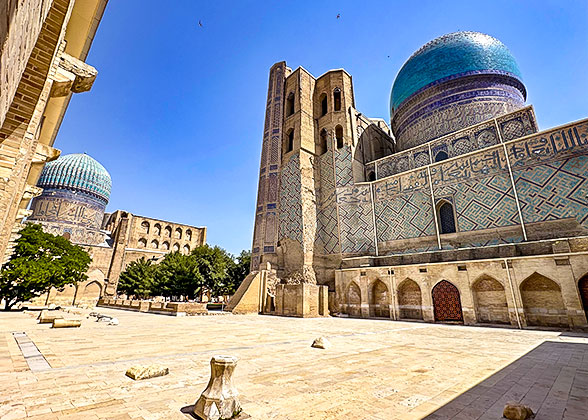
Bibi Khanym Mosque, Samarkand
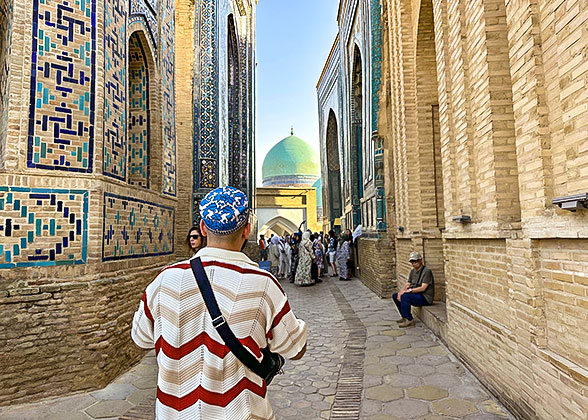
Shah-i-Zinda Necropolis
Day 10 Samarkand: Afrasiab Museum, Watch Papermaking; High-speed Train to Tashkent
Follow the guide’s steps, and you’ll probe into the Afrasiab Museum perched on a hill to the north of Samarkand, which was once the core of the Sogdian culture from the 6th century BC until Genghis Khan’s invasion in the 13th century. In 1965, ancient murals depicting the royal life and diplomatic scenes were excavated from the 12-hectare archaeological site, and five years later, the museum was founded to preserve relics discovered in the ruins. An 11-minute documentary will give you a detailed description of the fresco and the Sogdian civilization. Besides, you can see skulls of Sogdians, ceramic funerary ossuaries, and potteries.
Passing by the Tomb of Saint Daniel, the resting place of the biblical prophet of Samarkand, we will stop at the Koni Ghil Village, which is known for its ancient paper-making techniques. In the paper-making mill, you can witness the 9-step process of soaking, boiling, and mashing branches; skimming sheets with bamboo screens; pressing and sun-drying pages; and finally polishing with horns or shells. Moreover, you can find many peripheral products made by Samarkand paper, such as clothing embellished with silk embroidery and notebooks. After the guided tour, we’ll leave some time for you to explore the village on your own. Just wander along the babbling stream to hear the creaking of waterwheels, or sip a cup of tea beneath mulberry shade.
After returning to the city center of Samarkand in the afternoon, our driver will transfer you to the railway station for a high-speed train to Tashkent, where you’ll spend your last night in Uzbekistan. Upon arrival, the local driver will send you to the hotel.
Meals: Breakfast
Accommodation: Wyndham Tashkent (4 stars) or similar
Passing by the Tomb of Saint Daniel, the resting place of the biblical prophet of Samarkand, we will stop at the Koni Ghil Village, which is known for its ancient paper-making techniques. In the paper-making mill, you can witness the 9-step process of soaking, boiling, and mashing branches; skimming sheets with bamboo screens; pressing and sun-drying pages; and finally polishing with horns or shells. Moreover, you can find many peripheral products made by Samarkand paper, such as clothing embellished with silk embroidery and notebooks. After the guided tour, we’ll leave some time for you to explore the village on your own. Just wander along the babbling stream to hear the creaking of waterwheels, or sip a cup of tea beneath mulberry shade.
After returning to the city center of Samarkand in the afternoon, our driver will transfer you to the railway station for a high-speed train to Tashkent, where you’ll spend your last night in Uzbekistan. Upon arrival, the local driver will send you to the hotel.
Meals: Breakfast
Accommodation: Wyndham Tashkent (4 stars) or similar
Day 11 Departure from Tashkent, Airport See-off
At the end of your Uzbekistan desert tour, we’ll escort you to the Tashkent airport for a homebound flight. If you want to extend your Central Asian adventure, we can craft an itinerary for you to other Silk Road countries, such as Kazakhstan and Kyrgyzstan. Contact us for more information!
Meals: Breakfast
Meals: Breakfast
Expand All
Collapse All
This trip can be customized to meet your individual needs!
Tour Prices
Christmas & 2026 Specials: 12% off - Book before October 31, 2025
| Travelers | 2-3 travelers | 4-5 travelers |
|---|---|---|
| Year Round | USD2509 USD2207 | USD2049 USD1803 |
- Prices are per person on twin sharing.
- The prices in red reflect 12% discount.
- If you are a group of 6 people or more, we will offer a more favorable price by your group size.
Price Includes
- Economy class airfare of Tashkent - Nukus
- Train fare of Bukhara - Samarkand - Tashkent
- Accommodation with daily breakfast at selected hotels
- Service of English-speaking local guides for sightseeing
- Service of a private air-conditioned car with a driver
- Entrance fees for all mentioned sights visited
- Free bottled water daily in the vehicle
Price Excludes
- International flight into and out of Uzbekistan
- Meals other than those mentioned in the itinerary
- Personal expenses (such as laundry, telephone, drinks, etc.)
- Tips for guide and driver
- Personal travel insurance
- Uzbekistan visa fee
Itineraries you may also like:
 10 Days Tashkent - Urgench - Khiva - Kyzylkum Desert - Bukhara - Nurata - Safari Yurt Camp - Samarkand - Tashkent from USD1539
10 Days Tashkent - Urgench - Khiva - Kyzylkum Desert - Bukhara - Nurata - Safari Yurt Camp - Samarkand - Tashkent from USD1539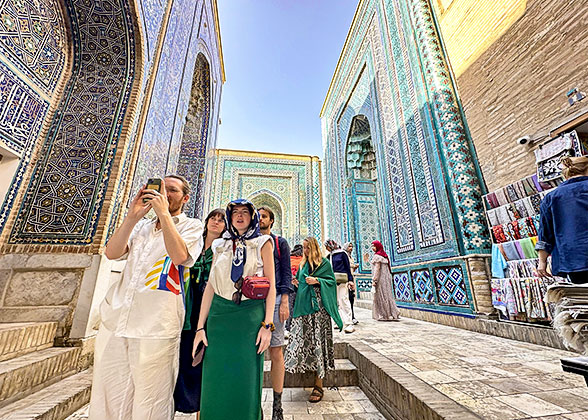 8 Days Tashkent - Samarkand - Bukhara - Kyzylkum Desert - Khiva - Urgench - Tashkent from USD1319
8 Days Tashkent - Samarkand - Bukhara - Kyzylkum Desert - Khiva - Urgench - Tashkent from USD1319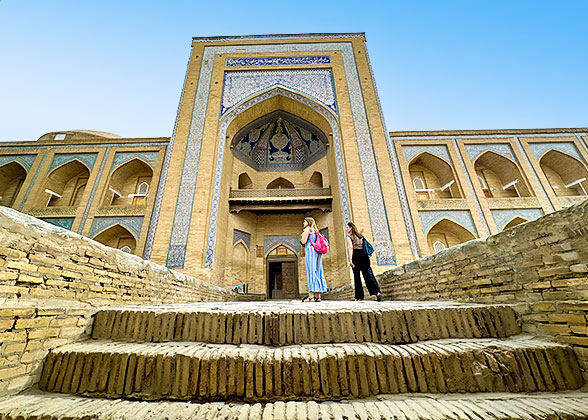 17 Days Tashkent - Nukus - Muynak - Nukus - Kunya Urgench - Darvaza - Khiva - Bukhara - Samarkand - Penjikent - Khujand - Fergana - Osh - Chon Kemin - Bishkek
17 Days Tashkent - Nukus - Muynak - Nukus - Kunya Urgench - Darvaza - Khiva - Bukhara - Samarkand - Penjikent - Khujand - Fergana - Osh - Chon Kemin - Bishkek
